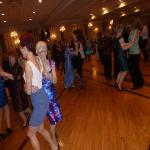March 16, 2011

Photo: VOA - A. Phillips
More than 500 Irish-Americans who trace their roots to County Mayo in Ireland gathered in a New York dance hall for an early St. Patrick's Day celebration.
Thursday, March 17, is Saint Patrick's Day, a time when native-born Irish and Irish-Americans will parade and pipe their way up Manhattan's famed Fifth Avenue. The 2011 event, which is expected to include well over 150,000 thousand marchers, will be the 250th annual Saint Patrick's Day Parade to be held in New York.
There was a foretaste of Saint Patrick's Day revelry at a dinner dance held last Saturday in a vast Queens New York catering hall. More than 500 Irish-Americans who trace their roots to County Mayo celebrated with visitors and well wishers who had come from County Mayo itself to join in the fun. County Mayo is just one of the 26 Irish counties represented in this year's parade.
Among the luminaries gaily holding their own among the dancers was Mary Higgins Clark, 83. The renowned author will be the Grand Marshall of this year's Saint Patrick's Day Parade. Clark says she is delighted to be celebrating her Celtic roots with her fellow Irish Americans, and adds that many of two million or so New Yorkers lining Thursday's parade route will be Irish in a certain sense, too.
"There is no question the sense of pride is the same. The people watching the parade, they are thinking of their own ancestors. They came over the same way. They came over in steerage," says Clark. "They were listed as laborers and they built themselves from the ground up. So I think, in a sense, everybody is Irish because everybody, or so many, are the children of immigrants, and they are seeing or watching the story they heard themselves." An unflattering political cartoon from 1871 titled 'The Usual Irish Way of Doing Things,' by Thomas Nast.
An unflattering political cartoon from 1871 titled 'The Usual Irish Way of Doing Things,' by Thomas Nast.
Hard times
The story of the first great wave of Irish immigration to New York is not a happy one. Millions of Irish arrived here during the 19th century. Many were seeking refuge from political or religious persecution. Others were fleeing the Great Famine of 1845 to 1852, when more than a million Irish died of starvation and disease.
The immigrants met further hardship when they reached New York.
"There was tremendous discrimination against them. Signs went up all over New York and Boston [that said] ‘No Irish Need Apply.' And they were always lampooned regularly in the press as idiots, as garbage. And so they need to get together," says Brian O'Dwyer, chairman of the non-profit Emerald Isle Immigration Center.
Making their mark
That experience sparked a deep involvement in local politics that continues to this day.
"We learned very quickly that the only way we could combat oppression is by being in and of ourselves, become part of the politics and making sure we took part in the American democracy," says O'Dwyer. "And that developed a whole brand new way of thinking by the Irish - as opposed to any other immigrant group before or since - that you needed to organize, that you needed to be part of the fabric of American society quickly so you could make your mark in America."
Indeed, Irish-Americans have made their mark in areas as diverse as labor unions, popular culture, law enforcement, journalism and finance. Famous Americans of Irish descent include John F. Kennedy and eight other U.S. presidents, the writers F. Scott Fitzgerald and Flannery O'Connor, industrialist Henry Ford, and boxing champions Jack Dempsey and Yankee Sullivan.
New wave
Tighter U.S. visa restrictions and citizenship requirements introduced during the 1960s, as well as an improved economy in Ireland over the past decade, slowed the rate of Irish immigration from its 20th century peak.
But the recent economic downturn has led to a new wave of Irish coming to New York, hoping to settle here. Emerald Isle Immigration Center chairman O'Dwyer says his organization helps thousands of Irish immigrants and would-be immigrants every year.
"America is different from Ireland with different customs, and different ways, and they are away from home for the first time and it's our job to make sure that they are welcomed and that the transition is easy for them," he says. "We tell them that no matter what anyone has told you, people in New York love the Irish and as long as you work hard, the sky is the limit as it has been for many, many generations before."